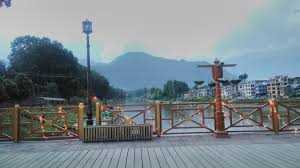
The Zero Bridge is an old wooden arch bridge in Srinagar, the capital of Kashmir. It stands over the Jhelum river in the north-south direction connecting the Sonwar area of Srinagar city in the north to the Rajbagh area in the south.
The original Zero bridge was constructed in the 1950s under the the then “prime minister of Jammu & Kashmir” – Bakshi Ghulam Mohammad. In the late 1980s, the bridge was shut down for vehicular traffic as the wooden structure began weakening. Zero bridge is only about two kilometers from the city center of Srinagar – Lal Chowk, but as everything in Srinagar, it does have its own charm.
The Zero Bridge is located very close to the Church Lane that houses the prime minister’s private office, state circuit house.
Zero Bridge
There are multiple stories around why this bridge came to be called the Zero Bridge. But before I tell you the different stories I have heard, let me tell you about the historic bridges of Srinagar.
The Amira kadal was regarded as the ‘first’ bridge in Srinagar out of the original seven bridges. Now, the more official version of why Zero bridge is called Zero bridge is that the Zero bridge preceded the Amira bridge. Amira bridge, as I just mentioned, was regarded as the ‘first’ bridge, and ‘zero’ precedes ‘one’, so this new bridge was came to be called ‘Zero bridge’.
Another story of why the Zero bridge is called Zero bridge is that this particular bridge was constructed by a local contractor who was apparently deaf. In Kashmiri, the word for deaf is ‘zorr’. So, the bridge was originally called ‘Zorr bridge’. With time, the name went from being ‘zorr’ to ‘zero’.
Zero Bridge status
Some years back, the wooden planks of the Zero Bridge began collapsing and the entire bridge was dismantled for repair. It had already been closed to vehicular traffic at that point and continues to remain so even today.
The current Zero Bridge is a spectacular marvel made of the wood from Deodar and Walnut trees, local to Kashmir and known for being highly durable in the river conditions where the bridge stands on the Jhelum.
Zero Bridge is considered to be a valuable part of the local heritage of Srinagar, which is why when the bridge was rebuilt, it was rebuilt as a wooden bridge and not replaced with a cement and mortar bridge which otherwise would have been a lot more durable.
The view from the Zero Bridge is amazing, there’s maple trees around, the Jhelum flowing below is serene, there is almost always a gentle cold breeze blowing. The night view from the bridge and of the Zero bridge is simply mind-blowing.
Zero Bridge signifies convergence, connecting two very different parts of a beautiful city, bridged together by the wood that is iconic for Kashmir.
The Zero Bridge is an old wooden arch bridge in Srinagar, the capital of Kashmir. It stands over the Jhelum river in the north-south direction connecting the Sonwar area of Srinagar city in the north to the Rajbagh area in the south.
The original Zero bridge was constructed in the 1950s under the the then “prime minister of Jammu & Kashmir” – Bakshi Ghulam Mohammad. In the late 1980s, the bridge was shut down for vehicular traffic as the wooden structure began weakening. Zero bridge is only about two kilometers from the city center of Srinagar – Lal Chowk, but as everything in Srinagar, it does have its own charm.
The Zero Bridge is located very close to the Church Lane that houses the prime minister’s private office, state circuit house.
Zero Bridge
There are multiple stories around why this bridge came to be called the Zero Bridge. But before I tell you the different stories I have heard, let me tell you about the historic bridges of Srinagar.
The Amira kadal was regarded as the ‘first’ bridge in Srinagar out of the original seven bridges. Now, the more official version of why Zero bridge is called Zero bridge is that the Zero bridge preceded the Amira bridge. Amira bridge, as I just mentioned, was regarded as the ‘first’ bridge, and ‘zero’ precedes ‘one’, so this new bridge was came to be called ‘Zero bridge’.
Another story of why the Zero bridge is called Zero bridge is that this particular bridge was constructed by a local contractor who was apparently deaf. In Kashmiri, the word for deaf is ‘zorr’. So, the bridge was originally called ‘Zorr bridge’. With time, the name went from being ‘zorr’ to ‘zero’.
Zero Bridge status
Some years back, the wooden planks of the Zero Bridge began collapsing and the entire bridge was dismantled for repair. It had already been closed to vehicular traffic at that point and continues to remain so even today.
The current Zero Bridge is a spectacular marvel made of the wood from Deodar and Walnut trees, local to Kashmir and known for being highly durable in the river conditions where the bridge stands on the Jhelum.
Zero Bridge is considered to be a valuable part of the local heritage of Srinagar, which is why when the bridge was rebuilt, it was rebuilt as a wooden bridge and not replaced with a cement and mortar bridge which otherwise would have been a lot more durable.
The view from the Zero Bridge is amazing, there’s maple trees around, the Jhelum flowing below is serene, there is almost always a gentle cold breeze blowing. The night view from the bridge and of the Zero bridge is simply mind-blowing.
Zero Bridge signifies convergence, connecting two very different parts of a beautiful city, bridged together by the wood that is iconic for Kashmir.
© Copyright 2023 brighterkashmir.com All Rights Reserved. Quantum Technologies